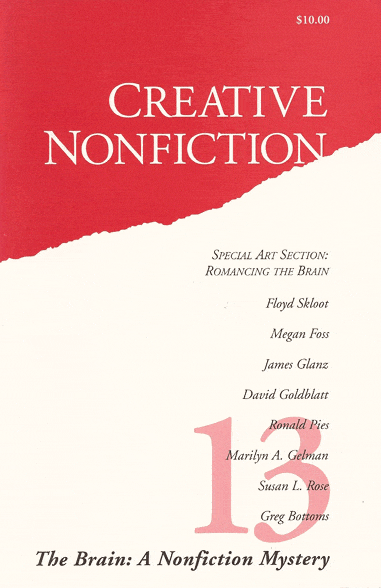Issue 13 / 1999

13 / The Brain: A Nonfiction Mystery
"The true source of all art and science"
“Nonfiction mystery” is an apt way of describing this issue and the themes surrounding the brain itself: memory, behavior, the creative process, intelligence, and perspective. No matter how much time, effort, or resources we invest in attempting to understand the brain and how it works, it remains elusive and daunting, which is perhaps why it has become the object of such attention. As has been aptly observed in one of these essays, it was Albert Einstein who noted: “The most beautiful thing we can experience is the mysterious. It is the true source of all art and science.”
This issue explores attempts to live normally with damaged brains, by Marilyn A. Gleman and Floyd Skloot, and with brains affected by drugs, by Megan Foss and Greg Bottoms. All are dramatic and tough illustrations of the complications that interfere with life when the brain is affected even slightly and subtly. Three scientists are also represented in this issue: Ronald Pies and David Goldblatt, both physicians, and James Glanz, a writer for Science.
Already a subscriber?
Read this issue nowTable of Contents
What’s the Story #13
“Through a strange legal fluke,” Megan Foss, one of the contributors of this issue, recently told me, “Someone sent me my medical records going back some 20 years, and there is a period of time—the best I can figure is about two-and-a-half to three years that describes events and conditions that not only do I have no memory of, but that I have always had entirely different memories of.”Gray Area: Thinking With a Damaged Brain
A damaged brain corrodes the author’s mind and sense of self, a state akin to “harboring a zombie”Perspectivo Scientifico or, Where the Rays Convene, I Fix a Point
Go to the pillar separating the medieval section of the museum from the gallery of Renaissance paintings and stop. If you listen carefully—very carefully—you can hear a quiet gasp as the medieval painter, after a hundred years of trial and error (give or take a few), finally grasps the notion of perspective and stumbles into enlightenment.Not in Love With AAMI
Might as well begin with the latest one: This morning, walking the beagle and thinking how to start this article, I began to pass the springhouse (a little shed over a cinderblock tank at the top of our hill), which I rebuilt last year in preparation for piping water to the outbuilding where I have my office.God, Glass, LSD: A Memory
My brother saw the face of God. You never recover from a trauma like that. He was 14, on LSD, shouting for help in the darkness of his room in our new suburban home.Thoughtprints
My yellow cat has epilepsy. The first time I was to witness one of its seizures, a quasihuman scream, torn from some fabric of terror and despair, startled me awake at about 3 a.m.The Music of the Brain, the Chemistry of the Lute
All right, let’s be honest. The brain is not a lute, and the six brain chemicals we will discuss are not precisely like the six strings of the lute. But the idea I want to explore—that the chemicals of the brain may be likened to specific musical tones—is not without precedent.East of Everything
I gained so much weight sitting in jail that my street clothes didn’t fit when they released me. I had to wear county-issue jeans and a T-shirt on the airplane I took out of California's Bay area that last time.Special Section: Romancing the Brain
We’re sorry; we’re currently unable to make this work available online.Scrambled Eggs
Life after brain injuryAbout the Author: Greg Bottoms
In My Brother's Madness: About Greg Bottoms, writer of "God, Glass, LSD: A Memory"
